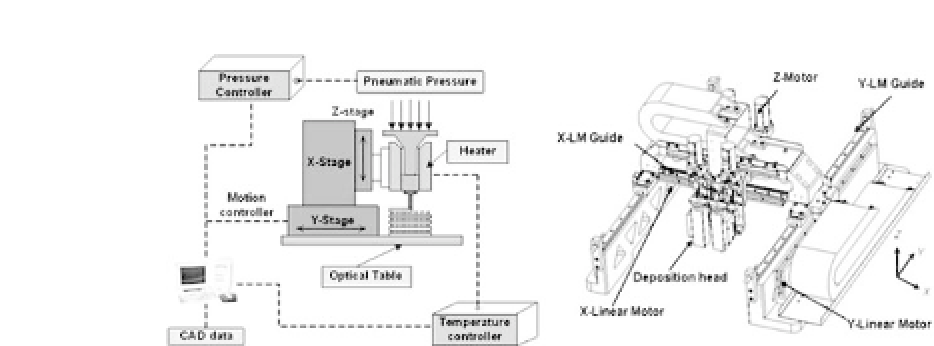Biomedical Engineering Reference
In-Depth Information
Figure 31.11.
(a) Schematic diagram of the developed MHDS and (b)
image of the designed and manufactured MHDS.
designedmicroscalefeatures.ThetypicalporesizeoffabricatedPCL
scaffold ranges from 200 to 300
μ
m, which is near the optimal size
suggested for bone tissue scaffold applications. The compressive
modulus of scaffolds ranges from 150 to 200 MPa. The preliminary
results of biological experiments demonstrate the biocompatibility
of the PEDprocess and PCL materials.
Kim
et al
.
26
,
34
described the adhesion of human BMSCs and
the proliferation characteristics of various scaffolds that consist of
biodegradablematerialsandthatwerefabricatedusingamultihead
deposition system (MHDS) developed by the authors (Fig. 31.11).
The MHDS may be superior to other commercialized systems using
theFDMprocessinthatitcanconvenientlyandquicklyfabricatevar-
ioushybridscaffolds.TheMHDSenablesthefabricationof3Dtissue
scaffolds with a resolution of several tens of microns (Fig. 31.12). In
addition, multideposition heads installed in the MHDS permit rapid
fabrication and manufacture of blended scaffolds with various bio-
material compositions. PCL, PLGA, blended PCL/PLGA, and blended
PCL/PLGA/TCP scaffolds, which had the same inner/outer archi-
tecture, were manufactured adequately and had perfectly intercon-
nected pores. The mechanical testing and cell proliferation results
show that the blended PCL/PLGA/TCP scaffold was superior to
other scaffolds. The feasibility of this application to tissue engineer-
ingofSFF-based3DscaffoldsfabricatedusingMHDSwasconfirmed
throughscaffoldfabrication,mechanicaltesting,andcellinteraction
evaluation.








Search WWH ::

Custom Search